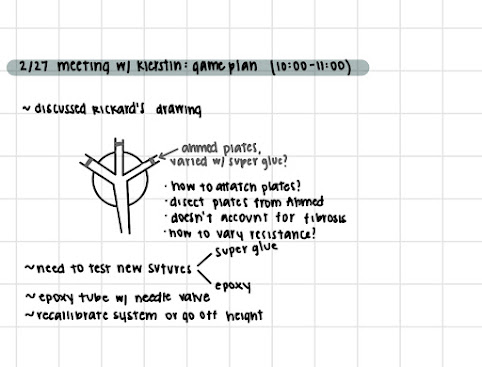This week in class we had presentations and pictures. I got to class early to pick up the valves as props for the presentation and to go over my slides one last time. The presentation I thought went really well. After the presentation I completed the peer evals. This semester I feel like we are all working really well together and have found our own individual strengths. This has allowed us to get a lot done and to work efficiently.
Kierstin and I had a planning meeting of two we were going to continue our project and figure out the specific pressure values and resistor sizes for dripping. In this meeting she also showed me the drawing that Dr. Rickard gave her. In this drawing he suggested using the Ahmed valves resistance mechanism and implanting it into out three tubing design system. we made a plan for how we were going to do this and other ways that we could make new resistors. One of our ideas was to fill our tube with hard epoxy and create resistors out of this. Later in the week we went into the lab to try this out.
Here are the notes from our meeting:
After this planning we went into the lab and tried to test Dr. Rickard's idea as well as our molded suture.
AHMED IDEA:
For this idea we did not realize that the valve in Ahmed is a plastic piece that we were able to pop out. After we figured this out we popped out 3 different Ahmed valves plates. We used one of our molded housing and manufactures it so 3 Ahmed plates with tubing could be attached. The housing was then sealed with a thin layer of the soft epoxy to prevent any leakage. This had to be left overnight to dry.
The next day we went in and here are our test results:
This was very promising and we will be continuing with this design.
EPOXY RESISTORS:
For this idea we had to fill a syringe with a hard epoxy and inject it into our tubing. We had two different epoxies to try. One was unlabeled and the other was unicone. The unicone was much thinner which made the process easier and this is the one that actually worked. Because we were using a syringe and a needle valve to fill the tube we had a lot of lab clean up to do to try and save the syringe.
Here was the process for that:
The next day we went in and tested and here is the data from this:
These results are not super promising and still need work. After the data collection I looked it over and did an analysis which is shown below:
I also did the Jira this week and looked at the class schedule to see what is coming up.











Comments
Post a Comment